Welcome to FISH FOOD TIMES
Jun. 2016 issue No.150-2

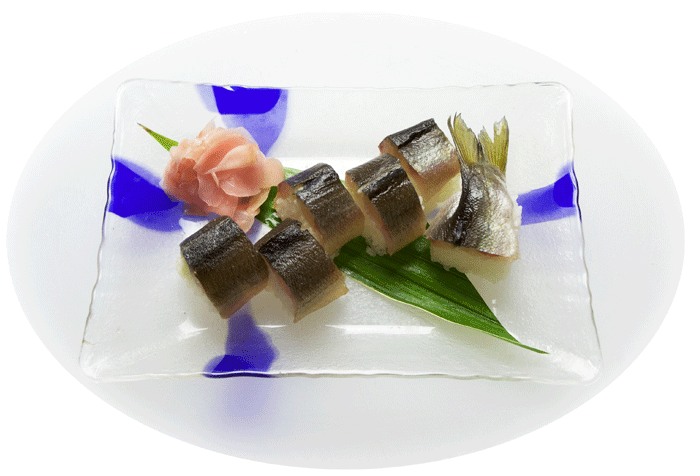
Ayu figure sushi
Then, try to mention the most popular grilled with salt on how to eat Ayu.
In the summer of outdoor cooking, the barbecue of meat is most popular I also can understand. But if a chimney starter in the dry river bed at the time of the summer camp, also because eat grilled skewered the Ayu on the side of the fire, I think that or not is brief entertainment of the blend into the natural landscape, but no longer saw such a sight quite today and it will be sorry.
Outdoors in to eat from the head while stabbed Ayu on skewers, you can feel the exceptional taste different from the always so wild in an exciting way of eating. And not particularly sought is such as beautiful appearance in the form of a skewer of ayu in such a scene. However, if this is Ayu grilled with salt proposals in the fish sales floor, to the still intriguing your appetite, it appeared to come out need to show good-looking even a little, some of the skills is also required in order that.
For example, there is a technique of skewering of fish called nobori skewer and odori skewer.
These skewered technique is a technique that has been used to a very commonplace in the shop of Japanese cuisine. But in the supermarket fish sales floor, such and it is almost gone to see the figure, there is also a fact that now an increasing number of the person in charge of the fisheries sector which does not even know that there is such a technique, a relatively simple on this occasion the steps of the "nobori skewer" in the way, trying to introduce the following.
| Noborikushi technique of Ayu | |
|---|---|
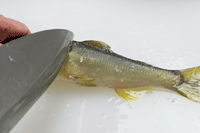 |
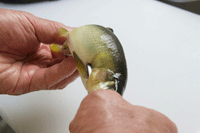 |
| 1, take with a kitchen knife the scales. | 4, Stab in the abdomen out the skewers from the gill lid. |
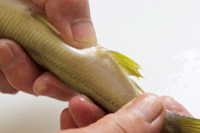 |
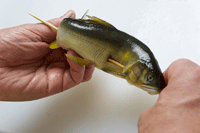 |
| 2, Push the feces by pressing the abdomen. | 5, through the abdomen, put out the skewer again. |
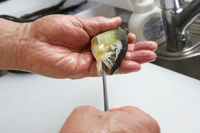 |
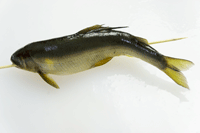 |
| 3, Interleaving the skewer from the mouth. | 6, In the form, such as the fish is undulate. |
When you stab a skewer of Ayu, the special care must be taken in the finish as a product based on the "basic Japanese that serve the fish in front of the abdomen to the left of the head", is that the skewer does not appear absolutely on the front side . This point is a big difference that the time of the private gatherings to eat Ayu of skewering a fire in the dry river bed, which is the maximum point of at the time of the skewer.
By the way, knotweed vinegar to Ayu grilled with salt that an inherent is as you know, the image below is a knotweed vinegar that has been served at Syunkoen. This knotweed vinegar is that mixed with mashed vinegar rubbed the leaves of knotweed, distinctive pungency was felt and put on Ayu grilled with salt.
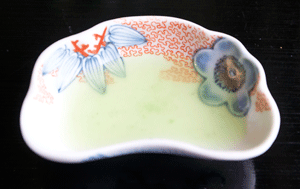
Knotweed has a pungent taste fragrance and unique, are used, such as in the tuma of condiments and sashimi as a spice, the most spicy wild red knotweed is in this, cultivated species of blue knotweed has a little spicy. The varieties Polygonum hydropiper (bottom of image), red knowweed, blue knotweed, a lobulet knotweed.
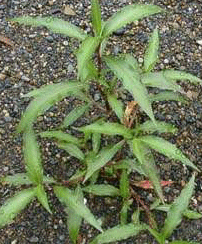
There is a proverb that "insect that eats the knotweed is like Favorite, respectively," but this is so that there are insects that eat prefer even some of the bitter taste, such as knotweed, preference of people is a metaphor that it is different.
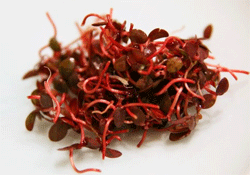
The image above is a red knotweed, this is what was harvested young buds before they full-fledged leaves a variant of polygonum hydropiper, usually are often used to tuma of sashimi, spicy and tangy just a little bit . Since the Red knotweed is relatively inexpensive, even usability good as Ashirai to put the color tone.
The following is a sushi using Ayu. We made two types of figure sushi and nigiri sushi. Working process is expressed as one is the same thing, those of different processes are separately represented side-by-side image.
| Nigiri Sushi and figure sushi of Ayu | |
|---|---|
 |
|
| 1、Take the scales of ayu surface with a knife.。 | |
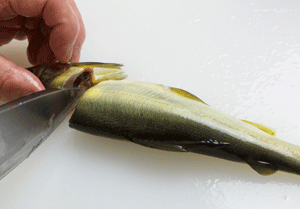 |
|
| 2、To cut off the head. | |
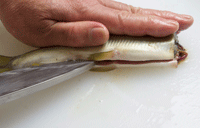 |
|
| 3、Open the abdomen to vertical. | |
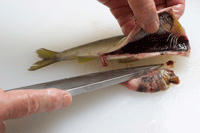 |
|
| 4、Take out the internal organs from the abdomen with a kitchen knife. | |
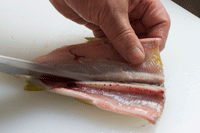 |
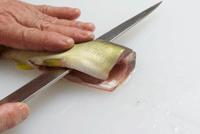 |
| 5、Proceed cuts the top of the mid-bone with a knife, to open. | 5、To daimyo dismantling the side of the lower body with a sashimi knife. |
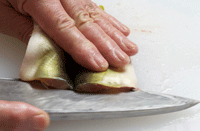 |
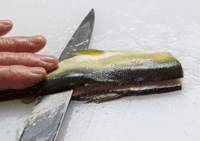 |
| 6、To open go cuts the upper body of the medium bone. | 6、 to dismantle the upper body in Daimyooroshi way. |
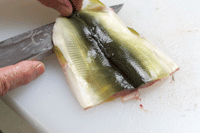 |
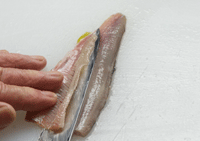 |
| 7、To open, last to cut off the medium bone. | 7、To remove the abdomen bone of the upper body side. |
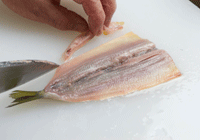 |
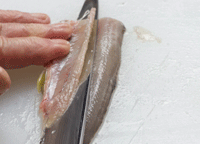 |
| 8、To remove both abdomen bone. | 8、To remove the abdomen bone of the lower body side. |
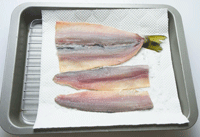 |
|
| 9、Put the fish that was dismantled lined with kitchen paper to bat provided with a space at the bottom. | |
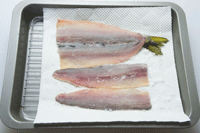 |
|
| 10、Shakedown the salt on top of the paper, also shake salt on top of the fish, take the water and left for a while. | |
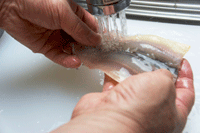 |
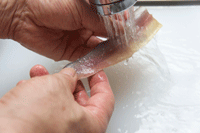 |
| 11、Flow to wash the fish of salt that was to open. | 11、To wash the salt of the fish that was dismantled in three pieces. |
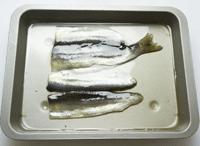 |
|
| 12、Pickled fish that was wiped off the moisture in the vinegar, allowed to stand for about an hour. | |
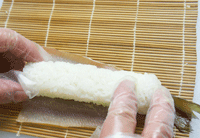 |
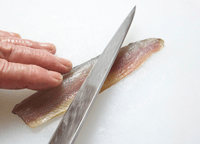 |
| 13、Put rounded the sushi rice on top of the open fish. | 13、To two cut the fish of three pieces dismantling diagonally. |
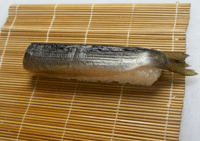 |
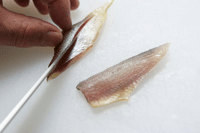 |
| 14、Use the Makisu, Rolling the fish open and sushi rice | 14、Put a knife decoration in the skin surface. |
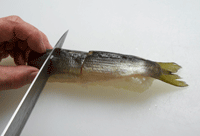 |
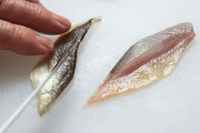 |
| 15、Cut into 6 equal parts. | 15、Also decoration kitchen knife to another fish skin. |
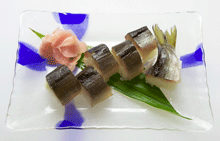 |
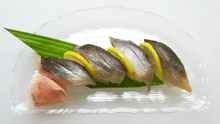 |
| Ayu figure sushi | Ayu nigiri sushi |
In the case of two of the products that were introduced to the above, but was commercialized by leaving the skin, as the method it is also possible of course commercialization of removing the skin. As a personal preference certainly is elegant it is better without the skin, but because out crunchy if there is a skin look can also express the ayu likeness, the author who of there skin feel preferably.
Well, Ayu of articles in this issue, which featured over two pages, we want to end soon.
Ayu have been enclosed as river fish, but the spring and summer are indeed living in the river, the sea between the autumn of larval and juvenile fish period, which accounts for about one-third of the ephemeral life of 1-year life of the winter in live. It is distinguished from other river fish that such life called "amphidromous".
Ayu is not only in Japan, the North is widely distributed in the whole area in East Asia from the vicinity of Hokkaido to the vicinity of the Vietnam of the south of the country. And larger rivers such as the Yangtze River and the Yellow River and the Mekong River in the continent with a very long under basin if anything, by the habit of eating the algae attached to the stone, inhabited prefer a relatively small river a kind of environment, in particular Japan in the river is the fish that have adapted best.
For this reason Ayu is has become a "Ayu" in English name, but there's also a fish that receive the like, such as the Japan of endemic species treatment.
It is an early summer charming sights Ayu is a fish of looking feel strongly the hot season, which is a fish of Japan's food scene is imagined naturally.
Though Ayu is not a cheap fish when converted into unit cost per 1kg, is a fish that can not be said in any way higher on the price per fish because the fish is small, different from the large Toro of bluefin tuna in the fish sales floor, to purchase I think that because the fish that can be purchased by anyone without the need for courage, our customers want to eat a lot more Ayu.
June is trying to sell a lot of Ayu.
| To previous page |
|---|
An opinion and the communication are to iinfo@fish food times
Date of updating Jun.1, 2016
